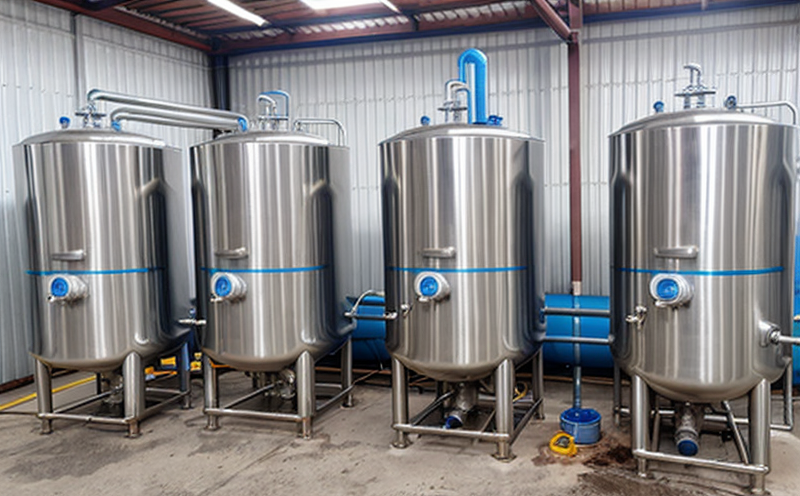ISO 5815 Biochemical Oxygen Demand BOD Test in Cooling Water
The ISO 5815 biochemical oxygen demand (BOD) test is a critical analytical procedure used to assess the quality of cooling water systems, particularly in industrial settings. This test provides insights into the presence and concentration of biodegradable organic matter that can be decomposed by microorganisms under controlled conditions. In this article, we delve deeply into the ISO 5815 BOD test for cooling water, exploring its importance, benefits, and how it contributes to maintaining system efficiency and environmental compliance.
The biochemical oxygen demand is a widely recognized parameter used in various industries to measure the biological activity of water. The ISO 5815 standard specifies methods for determining the biodegradable organic matter present in water samples using a five-day incubation period at 20°C. This test helps operators and engineers understand the potential for microbial growth, which can lead to scaling, fouling, or corrosion within cooling systems.
The relevance of the ISO 5815 BOD test extends beyond just monitoring the quality of water in industrial processes. It also plays a crucial role in ensuring regulatory compliance with environmental protection regulations such as the Clean Water Act (CWA) in the United States and similar laws worldwide. By conducting this test, facilities can ensure that they are not discharging pollutants into receiving waters at levels that could harm aquatic life or human health.
Understanding the BOD concentration in cooling water is essential for optimizing water treatment processes and extending the service life of equipment. For instance, if the BOD level is too high, it may indicate that there is excess organic matter that can lead to biofilm formation on heat exchangers or other components of the cooling system. This not only increases energy consumption but also reduces the overall efficiency of the plant.
The ISO 5815 test is conducted by collecting a representative sample of cooling water and incubating it under controlled conditions for five days at a specified temperature (20°C). During this period, microorganisms present in the sample consume oxygen as they decompose organic matter. The amount of oxygen consumed provides an indication of the biodegradable organic content.
Once the incubation is complete, the dissolved oxygen concentration in the sample is measured before and after the test. The difference between these two values gives the BOD5 (biochemical oxygen demand at 20°C over five days) value. This number represents the potential for biological activity that could impact system performance.
Operators of industrial facilities can use this information to adjust their water treatment strategies, such as increasing disinfection levels or adjusting pH and alkalinity levels. Proper management of BOD5 in cooling water is vital for maintaining optimal conditions within the system while minimizing environmental impacts.
In summary, conducting an ISO 5815 BOD test on cooling water is not just about compliance; it's a proactive approach to managing critical resources effectively. By regularly monitoring and controlling BOD levels, facilities can enhance operational efficiency, reduce maintenance costs, and contribute positively to environmental sustainability.
Why It Matters
The importance of the ISO 5815 BOD test in cooling water cannot be overstated. It serves as a key indicator of the health of the water system and helps prevent potential issues before they escalate into costly repairs or environmental violations.
- Prevents Biofouling: High BOD levels can lead to biofilm formation, which clogs heat exchangers and other equipment. Regular monitoring ensures that any buildup is addressed promptly.
- Ensures Compliance with Regulations: Many regions have strict limits on the amount of biodegradable organic matter that can be discharged into public waters. The ISO 5815 test helps ensure compliance with these regulations, avoiding fines and legal penalties.
- Safeguards Equipment Integrity: Excessive BOD levels can accelerate corrosion rates in metal components, leading to premature equipment failure. Monitoring BOD allows for timely interventions that protect investment in plant assets.
The ISO 5815 test is a cornerstone of effective water management strategies, providing actionable data that supports informed decision-making at every stage of the process.
Benefits
- Enhanced Operational Efficiency: By maintaining optimal BOD levels, facilities can reduce energy consumption and improve overall system performance.
- Extended Equipment Lifespan: Proper management of BOD helps prevent corrosion and other forms of degradation, extending the life of critical plant assets.
- Avoidance of Environmental Impact: Ensuring that discharge levels meet regulatory standards minimizes harm to local ecosystems.
- Prompt Issue Resolution: Regular testing allows for early detection of problems, enabling quick corrective actions and preventing major disruptions.
The ISO 5815 BOD test offers a comprehensive approach to maintaining water quality in cooling systems. It provides valuable insights into the biological activity within these systems, helping operators make informed decisions that balance operational needs with environmental responsibility.
Quality and Reliability Assurance
The ISO 5815 BOD test is renowned for its accuracy and reliability in measuring biodegradable organic matter. This standard ensures consistent results across different laboratories, making it a trusted method for quality assurance programs.
- Consistent Methodology: The standardized procedure guarantees that all samples are tested under the same conditions, ensuring comparability between results from various testing facilities.
- Trained Personnel: Laboratories adhering to this standard employ trained personnel who follow strict protocols, enhancing the reliability of test outcomes.
- Regular Calibration: Instruments used in the BOD analysis are regularly calibrated against certified reference materials, ensuring precision and accuracy.
In addition to these technical aspects, quality assurance also involves maintaining comprehensive documentation of all testing procedures. This includes detailed records of sample collection, preparation, incubation conditions, and final measurements. Such thorough documentation supports traceability and accountability throughout the entire testing process.
The ISO 5815 BOD test is a robust tool for ensuring that water treatment processes are effective and efficient. By adhering to this standard, facilities can build confidence in their water management practices, knowing that they are meeting both internal requirements and external expectations.





